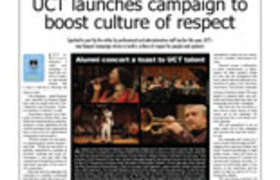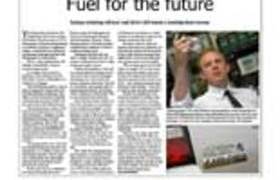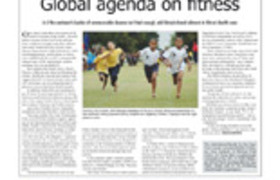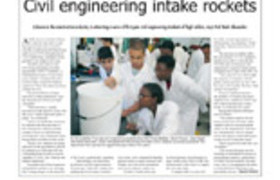How the Aussies do it
21 May 2007At the end of November 2006, the Higher Education Quality Committee (HEQC) set off on an AusAid-funded fact-finding mission to Australia. Also on the trip were Dr Tembeka Mpako-Ntusi, director of research at Walter Sisulu University; Professor Jan Botha, director of academic planning at the University of Stellenbosch; and Judy Favish, director of institutional planning at UCT. Here Favish shares a few insights into that visit, particularly on the benchmarking between a group of Australian universities dubbed as the Group of Eight.
The objectives of the study tour were:
- To establish or strengthen links between research-led universities in the two countries.
- To discuss the benchmarking of research-led universities.
- To discuss how the universities link their quality management information systems for research with the planning and management of research.
- To discuss the ways in which different institutions select and use benchmarks and performance indicators for the quality management of research.
With the exception of the University of Canberra, all the universities visited by the delegation are members of the Group of Eight (Go8), a collaborator of Australian "research-intensive" universities. This group consists of the Universities of Sydney, New South Wales, Melbourne, Adelaide, Queensland, Western Australia, the Australian National University and Monash.
The Go8 operates as a serious coalition for the purposes of lobbying government and exchanging quantitative data as well as information about processes, practices and policies. The Go8 have established various specialised fora to facilitate the exchange information.
The institutions have allocated resources in one institution to calculate GO8 averages and institutional ratings for various indicators.
The location of institutions informs the processes of setting institutional targets for improvement. In this sense the competition between the institutions helps to move the Go8 averages up and hence contributes to systemic improvements.
The members of the Go8 stipulate that the data is confidential and can't be used for promotional or marketing purposes.
The following characteristics were identified as important in defining institutions as "research-intensive":
- Doctoral intensive
- Size of budget for research
- Proportion of master's and doctoral students
- Exposure of undergraduate students to top researchers
- The promotion of a research-led undergraduate culture
- Appointments of people based on research track record and interests
- Importance of quality undergraduate teaching to attract students to postgraduate programmes
- Destination for postdocs
- International rankings in relation to research outputs.
Lessons learned:
- The practice of benchmarking appeared to be totally embedded in a very strong culture of continuous improvement, which permeates the way in which all the institutions visited approach their planning and review systems. More particularly, benchmarking is used to identify areas for improvement at faculty and departmental level. As a result there are strong links between benchmarking and performance management. For example, at the University of Melbourne improving the position of a department that is below the group average, or lower down in the rankings, forms part of the deans' performance objectives. At UWA, budgetary allocations are informed by outputs. Hence resources are shifted away from parts of the university where the student outputs are poor to other parts where the outputs are better. Faculties whose performance is below the Go8 averages are required to integrate strategies for improvement into their faculty plans.
- Monash has a set of 30 indicators and for each of these improvement targets are set. Performance is monitored in dashboard (or traffic light) format. The targets for most of the indicators are expressed as a position in relation to the Go8. Most of the indicators are therefore norm referenced - with the Go8's average as the norm to measure and judge their performance on research, education, international, equity, environment and administration while three international rankings (the Shanghai Jiao Tong University Ranking of World Universities, the Times Higher Education Supplement World University Ranking and the Newsweek Global University Ranking) are used as the measure for their reputation. In contrast to the other universities visited, Monash University takes these rankings quite seriously.
- Benchmarking activities are not limited to comparisons of quantitative data. They include comparative information on the results of national qualitative surveys such as graduate exit surveys, and student satisfaction surveys.
- Continuous improvement is promoted through the exchange of information at various fora organised by the Go8 as well as through ad hoc arrangements between particular institutions to exchange information on particular practices.
- All of the institutions visited also make use of strategic benchmarking with international institutions. They identify institutions with whom they feel they share common aims and values but whom they perceive to be better in particular aspects of their work. The purpose of the exchange of the information is to stimulate continuous improvements. For example, the University of Melbourne has agreements with the Universities of Berkeley and Oxford. Monash benchmarks themselves against three British institutions. UWA has agreements with a Canadian and a British institution.
- Benchmarking is integrated into the academic reviews. For example, at the University of Queensland, units of review are required to identify two other institutions against which they will benchmark themselves as part of their self-evaluation. Schools are then expected to benchmark themselves against two other Australian universities and against one international university. The motivation for the choice of the particular institutions must be provided. The comparative data forms part of the review documentation.
Benchmarking within different groupings of institutions on the basis of institutional types is a strong feature of the Australian higher education system.
While we in South Africa are committed to developing a single, differentiated higher education system, I believe that our apartheid legacy would make it problematic to formalise a grouping of research-intensive, historically white institutions.
However, I think we should certainly explore the establishment of various kinds of fora to facilitate sharing information between institutions of different types.
I certainly feel that UCT should reflect on ways of integrating comparative information into our planning and review processes, but more importantly, on how we can encourage all staff to think about how benchmarking can be used to promote and strengthen a culture of continuous improvement.
 This work is licensed under a Creative Commons Attribution-NoDerivatives 4.0 International License.
This work is licensed under a Creative Commons Attribution-NoDerivatives 4.0 International License.
Please view the republishing articles page for more information.
Monday Monthly
Volume 26 Edition 07
21 May 2007
Front page
Research and innovation
Affirmative Action debate
Sport
News
Governance
Front page extra
Previous Editions










